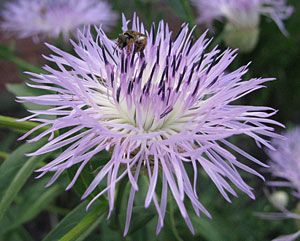Basketflower

© Flo Hannah
Plectocephalus americanus
Family: Asteraceae (Aster Family)
Basketflower (Plectocephalus americanus), sometimes known as American Basketflower, is a stunning native annual or biennial wildflower known for its large, fringed lavender-pink blooms and distinctive bract-covered buds that resemble woven baskets. Commonly found in prairies and open fields throughout Texas, this eye-catching plant is not only beautiful but also a great attractor of pollinators.
- Scientific Name: Plectocephalus americanus
- Common Names: Basketflower, American Basketflower
- Family: Asteraceae (Aster Family)
- Growth Habit: Upright annual or biennial
- Height: 2 to 5 feet
- Leaves: Long, narrow, rough-textured leaves with toothed margins
- Flowers: Large, thistle-like lavender-pink flowers with creamy centers; papery bracts resemble a woven basket
- Bloom Time: Late spring to summer
- Wildlife Benefits: Attracts bees, butterflies, and other pollinators
Habitat & Range in Southeast Texas
Basketflower thrives in:
- Prairies & Grasslands: Especially in sandy or well-drained soils
- Roadsides & Open Fields: Tolerant of disturbed areas
- Sunny Meadows: Prefers full sun and open conditions
This adaptable species does well in dry to moderately moist soils and adds a dramatic flair to native landscapes.
Ecological Importance
- Pollinator Magnet: Offers abundant nectar and pollen to native bees, butterflies, and more
- Erosion Control: Root systems help stabilize soil in open landscapes
- Biodiversity: Supports insect diversity and ecosystem health
Landscaping & Gardening Uses
Basketflower is a showstopper in:
- Wildflower Meadows: Adds height, color, and texture
- Pollinator Gardens: Draws a wide variety of beneficial insects
- Naturalized Landscapes: Resilient and easy to grow in sunny areas
Planting & Care
- Sunlight: Full sun
- Soil: Well-drained, sandy or loamy
- Water Needs: Low to moderate
- Maintenance: Minimal; deadhead to encourage longer bloom period if desired
- Companion Plants: Pairs well with Firewheel (Gaillardia pulchella), Standing Cypress (Ipomopsis rubra), and Prairie Coneflower (Ratibida columnifera)
Fun Facts
- The name “Basketflower” comes from the intricate, basket-like bracts that surround the flower head.
- Though it resembles a thistle, Basketflower lacks the spines that make thistles difficult to handle.
- It often self-seeds and returns year after year in favorable conditions.
Conservation & Native Plant Advocacy
By incorporating Basketflower into your garden or restoration project, you help provide essential nectar sources for native pollinators and add seasonal beauty to Texas landscapes. Its unusual appearance makes it a conversation piece in any setting.
Where to Find It
-
Interested in adding Basketflower to your garden? Check if this is in stock or add to cart to purchase directly from our Natives Nursery.


